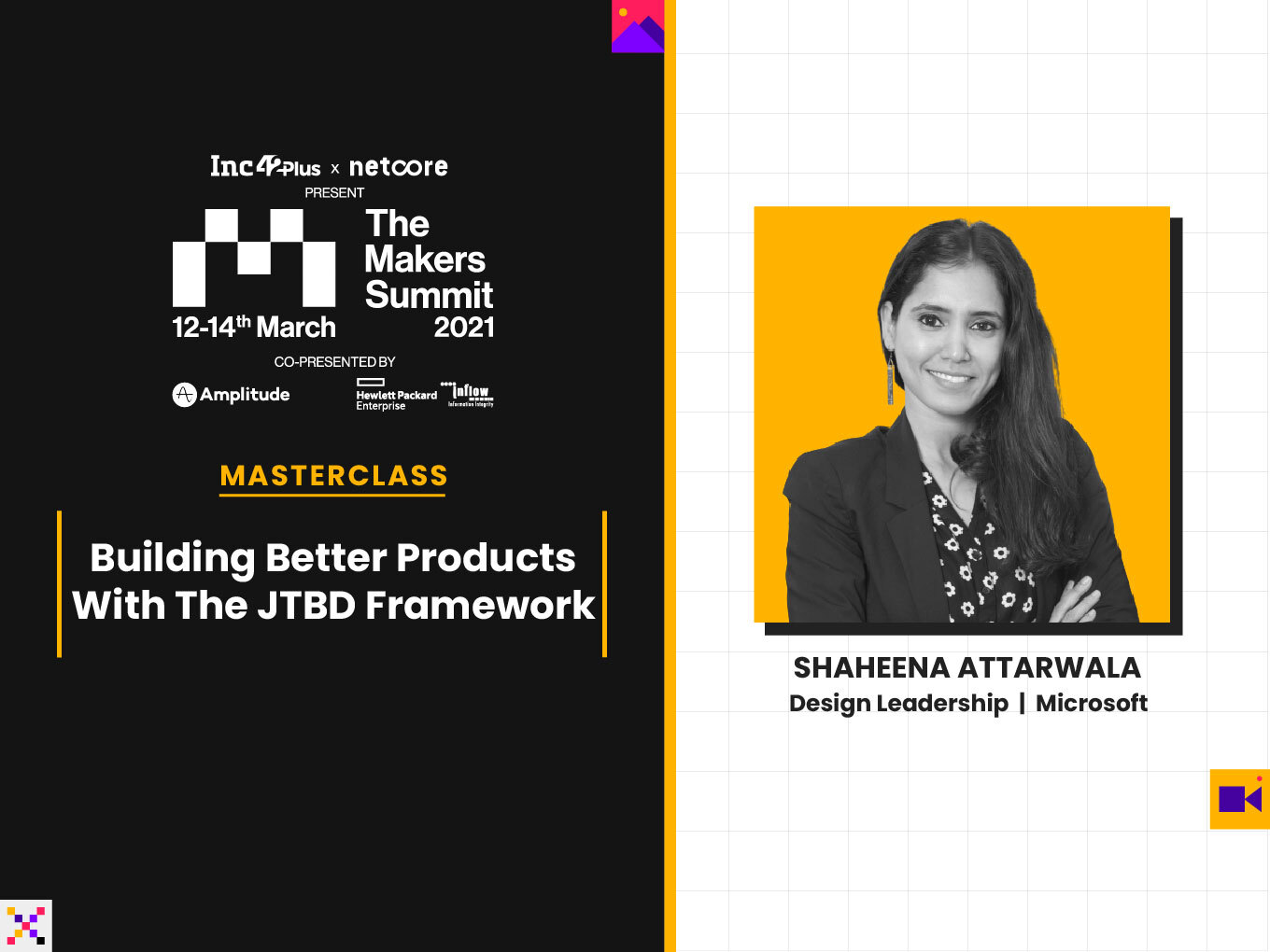
“If I had asked people what they wanted, they would have said faster horses.”
For Shaheena Attarwala, this quote from Henry Ford has served as an inspiration in her product leadership journey. She uses it to illustrate just how essential it is to understand that it is not only about what people want, but also anticipating what innovation will change their lives for the better.
As a product maker, this is the job to be done or JTBD and this is what will guide product teams towards success, said the noted experience design manager at Microsoft during her masterclass at The Makers Summit 2021.
Beyond taking the audience through the JTBD framework and how it guides product development, Attarwalla spoke about the need to keep the customer at the centre of all features.
Her own experience is inspired by Clayton Christensen, a noted professor at the Harvard Business School, who coined the term ‘Job To Be Done’ or JTBD. She brought forward six points, which we have encapsulated as four tenets below, supported by real-life examples of how companies built products.
Click To Access The Makers Summit 2021 Sessions
Tenet 1: Customers Don’t Just Use Products, They Want To Get A Job Done
An important approach for all makers creating products for the end consumers, this tenet is about knowing your user base and creating accordingly. It’s about knowing what are the various needs and requirements from the product for these users and absorbing them into product creation by building a JTBD problem statement.
Shaheena Attarwala shared Harvard Business School professor Theodore Levitt’s example, “People don’t want a quarter-inch drill, they want a quarter-inch hole.”
She explains how he went on to say that consumers want that hole for a reason which might be for a wall hanging or a bookshelf that fulfils their need for self-expression, whereas the drill is just the tool to get them there. And this is the innate need or job requirement that product makers ought to spot, she says.
Tenet 2: Define The Job Clearly
Each job for a product maker or from the customer point of view has to be defined at the right level. If the job is too broadly stated then the innovation will remain stagnant, Attarwala says. For example, a lawnmower’s job cannot be to beautify the community at large. Similarly, setting a very narrow definition might not be enough for the addressable base. Here, a lawnmower’s job cannot be too specific like just cutting grass.
It is important to get to the right level of the product’s job which in the case of the lawnmower is keep the lawn tidy. This helps the product maker in innovating in the right manner, either within an existing product or a new product.
The purpose is to get the job done and keep discovering new things to wrap up the job conveniently. The maker needs to cut down the tasks involved to reach the end outcome which is job completion. She gave another example; this time talking about Keurig’s range of instant coffee products which replaced kettles because it automated many of the tasks that a user had to manually take on to brew a cup of coffee.
Click To Access The Makers Summit 2021 Sessions
Tenet 3: Jobs Follow A Pattern
Taking cues from Albert Einstein, Attarwala says that learning to frame the JTBD in a single crisp line is crucial. Till the time the problem hasn’t been understood, wandering for solutions won’t do anybody any good. According to this tenet, every job follows a pattern i.e verb, object and context.
Taking an example of music apps, she says that the act of listening to music has evolved over time, trying to meet the latent needs of the users. And now, with a variety of apps on our mobile phones, music can be heard anywhere and at all times. In this category, the job can be broken down as such:
(Verb) To listen- (Object) To music- (Context) While on the go
Tenet 4: Jobs Stay The Same Over Time But People’s Needs Evolve
The fundamental idea behind any product is to understand that it enables consumers to accomplish a job, which is correctly defined. This means that products will come and go but the job remains the same. From large boom boxes to portable Walkman and MP3 players and now streaming services, products have evolved, but the job is to help users listen to music. However, here the people’s needs evolved from only listening from a fixed physical location to being able to listen on-the-go. So new-age music products take on the same job as a gramophone from centuries ago, but evolve with the customer.
However, to be able to do this, it is necessary to understand the customer’s JTBD as well as the product’s JTBD. Using Christensen’s videos on talking to customers and intricately studying customer behaviour, she showed how product makers can understand the ‘why’ and ‘what’ for users.
Identifying the job, pulls makers closer to the pain points of the customer. Once the pain points have been studied, makers can reach the metrics used by consumers to measure success and then build a product that solves customer’s problems.
At the same time, solving for an irrelevant job or pain point can be a waste of energy. Not all points are painful enough so a rule of thumb to be followed is to look for problems that customers are trying to solve. Here, Attarwala referred to new-age concepts such as empathy mapping to get closer to customers, create the right job hypothesis, screening this through data and then creating a product that really resonates with the audience.
The post Microsoft Design Leader On The Four Tenets To Build Better Products With The JTBD Framework appeared first on Inc42 Media.
0 Comments